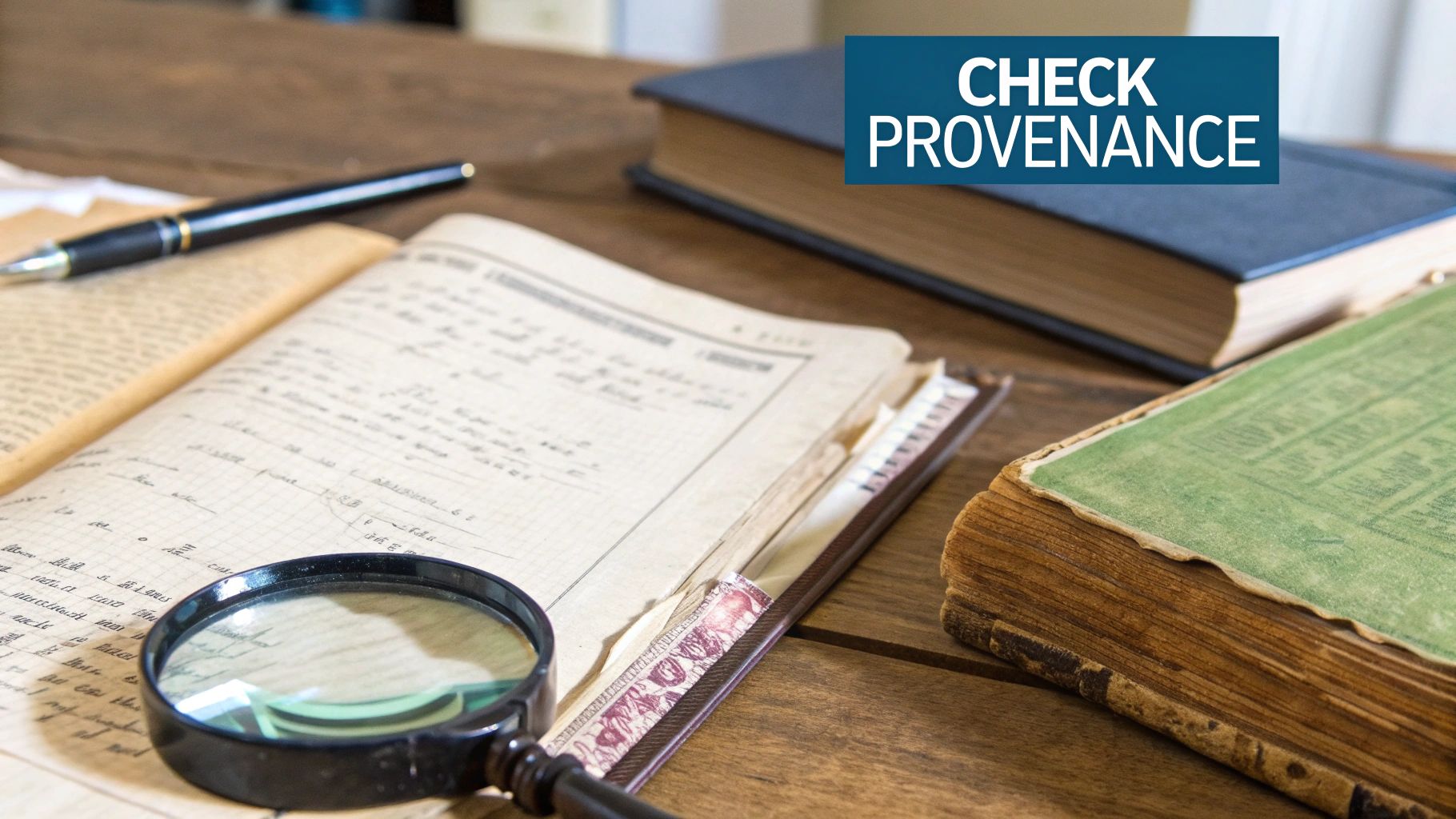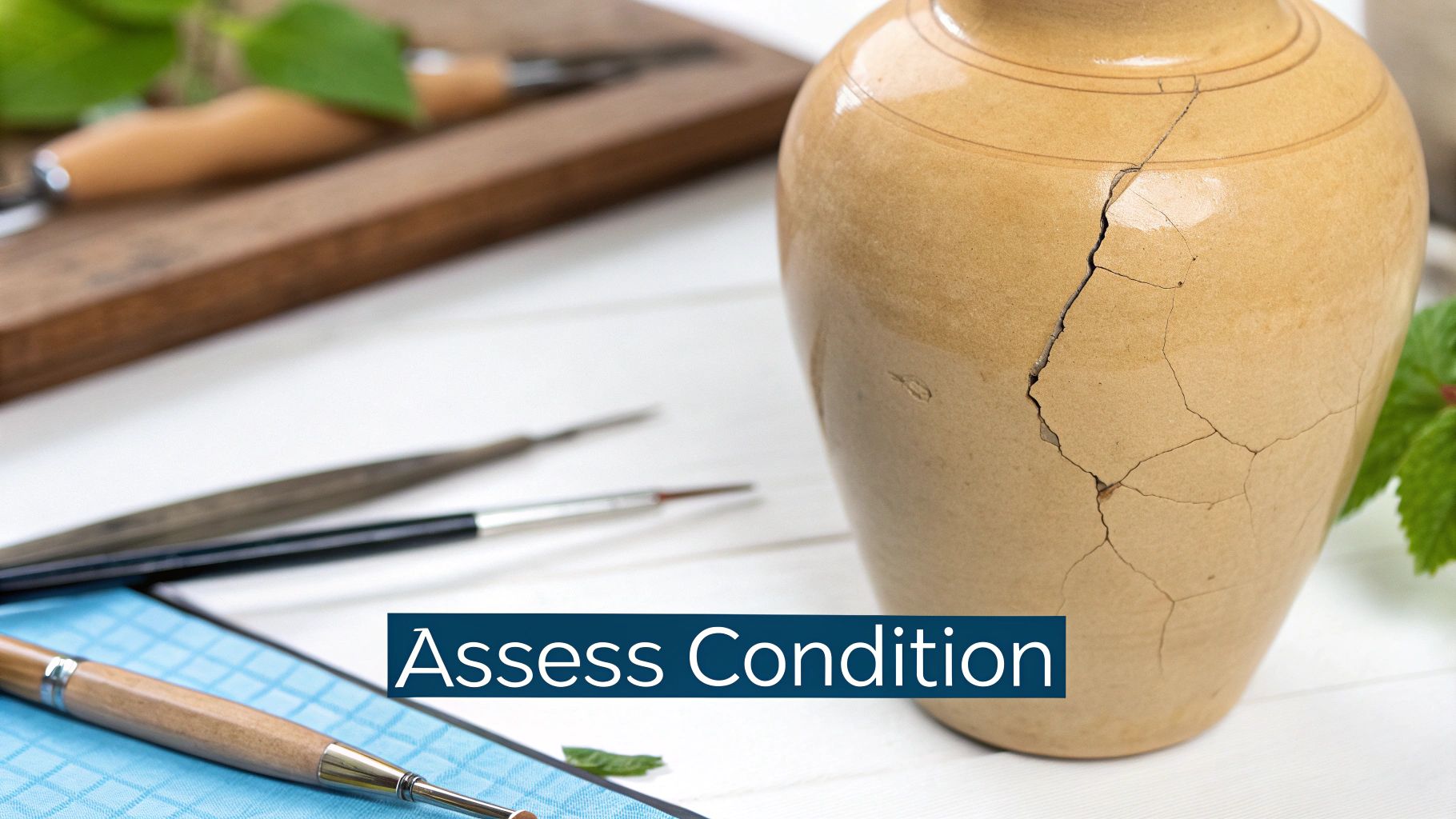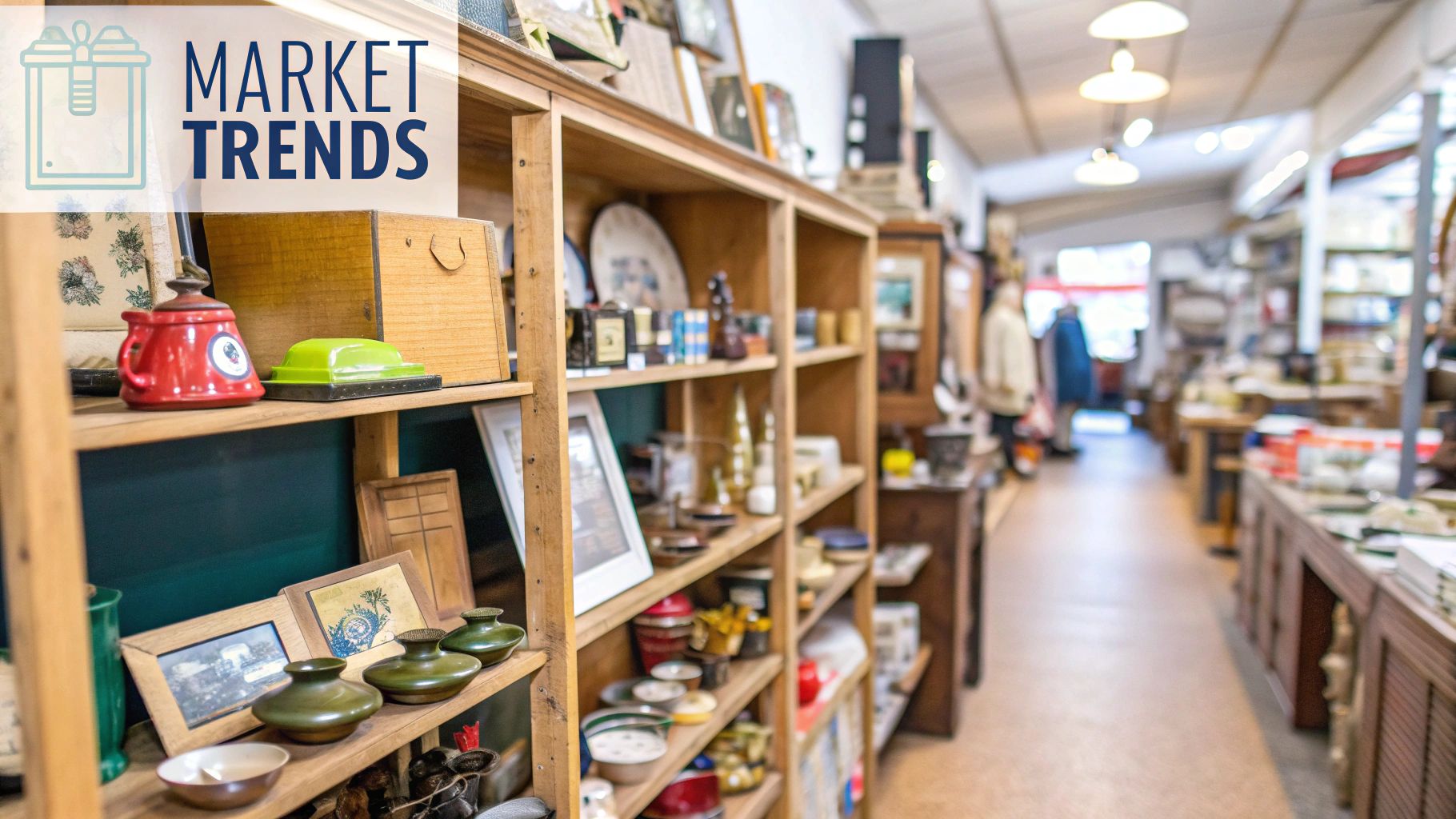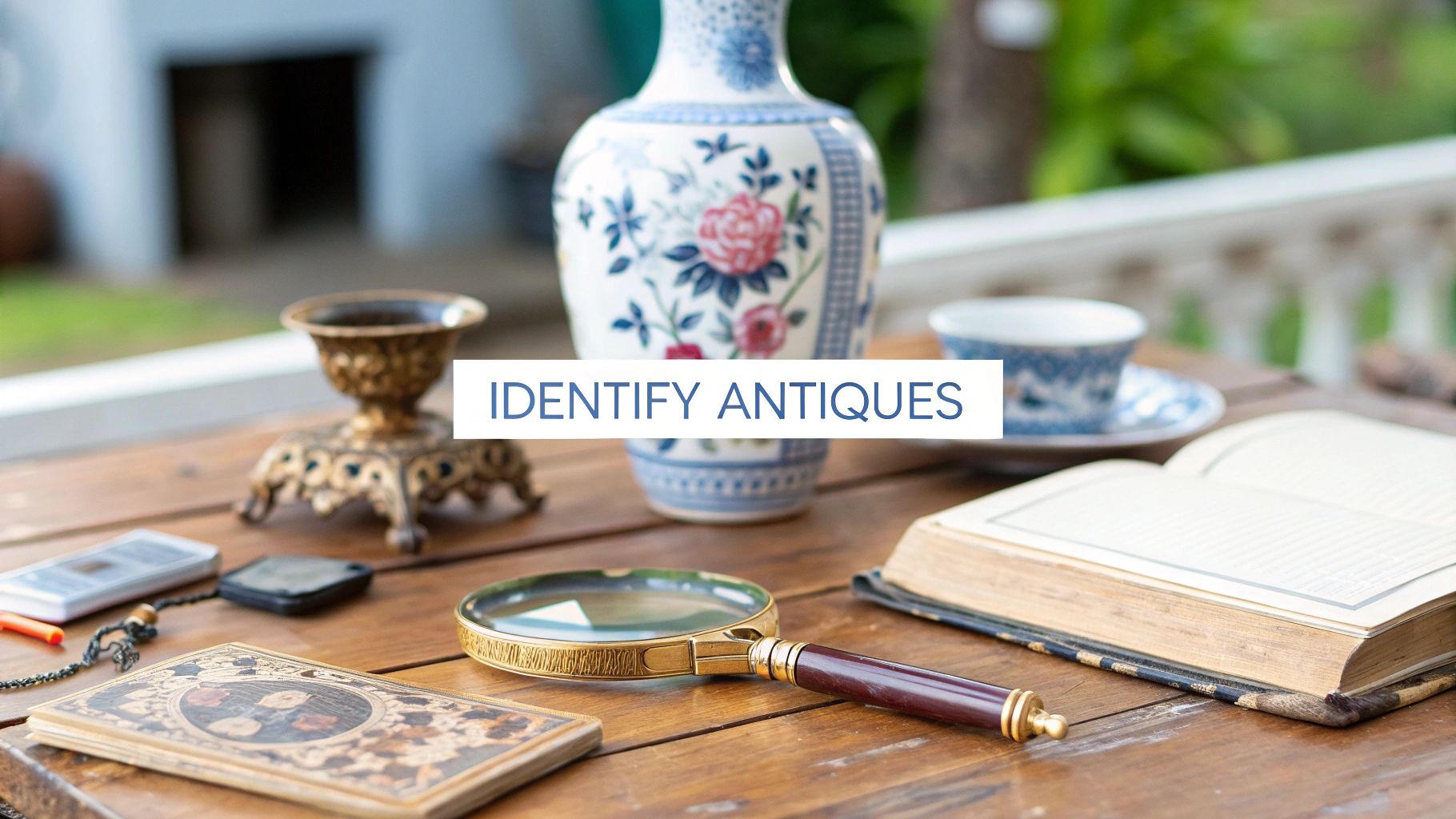So, you're standing in a packed flea market, and something catches your eye. It looks old, maybe even special. But is it valuable? This is the moment every antique hunter lives for, but it can also be overwhelming. Where do you even start?
The secret isn't some mystical sixth sense. Experienced collectors and appraisers use a mental checklist to quickly size up a piece. I like to call it the RADAR framework: Rarity, Aesthetics, Desirability, Authenticity, and Really good condition. Once you get the hang of it, you'll have a reliable guide for any treasure hunt, whether you're in a dusty attic or a high-end antique shop.
Starting Your Antique Treasure Hunt
Getting into antiques is about learning to see what other people miss. It's about training your eye to spot the hidden stories and potential value in everyday objects. While developing that expert intuition takes time and experience, it all starts with understanding the basic principles of what makes something valuable.
Think of these pillars as your first-pass filter. Before you even think about pulling out your phone for research or getting out a magnifying glass, a quick mental scan using this framework can tell you if an item is worth a second look. It's the difference between being a casual browser and a serious hunter who knows how to spot potential.
To help you remember these core concepts, I've put them into a simple table.
The RADAR Framework for Quick Antique Evaluation
This table breaks down the five key pillars you should consider when you first encounter a potential antique. It's a quick reference to help you evaluate an item on the spot.
| Pillar | What It Means for Value |
|---|---|
| Rarity | Is it one of a kind, or were thousands made? Fewer available pieces generally mean higher value. |
| Aesthetics | Does it look good? Exceptional design, beauty, and craftsmanship often fetch higher prices. |
| Desirability | Is this style or maker in demand right now? Collector trends can make or break an item's market value. |
| Authenticity | Is it the real deal? A genuine period piece is always more valuable than a reproduction or a fake. |
| Really Good Condition | How well has it held up? Damage and poor repairs can drastically lower the price. |
Each of these elements plays a crucial role, and they often work together to determine what an object is truly worth in the marketplace.
A classic rookie mistake is getting hung up on age alone. I've seen it a hundred times. An unremarkable, 120-year-old chair that was mass-produced might be worth less than a highly sought-after designer piece from the 1960s. Desirability and condition can easily trump age.
Decoding Maker's Marks and Signatures

For me, the real thrill of the hunt is that moment you find a hidden stamp or signature. These maker's marks are like little fingerprints left by history, giving you a direct clue to who made an item, where it came from, and roughly when. Learning to spot and understand these marks is one of the most important skills you can develop.
They aren't always easy to find, though. It’s a bit of a treasure hunt, and I’ve found them in some of the most unusual spots. You have to think like the creator: where could they add a mark without ruining the look of the piece?
Where to Start Your Search
Based on my experience, here are the most common hiding places:
- Ceramics & Glass: The first place to check is always the bottom or base. You're looking for marks that are pressed into, cut into, or printed on the surface.
- Furniture: Get ready to do some digging. Check the back, underneath the top, inside every drawer, and even on the drawer bottoms. Sometimes you'll get lucky and find an old paper label still stuck to the inside of a cabinet door.
- Silver & Jewelry: Look carefully along the edges, on the back, or near the clasp. You'll often find a series of tiny symbols—these are called hallmarks.
What to Do When You Find a Mark
Once you've located a mark, the real detective work begins. They come in all shapes and sizes, from simple initials or a full name to complex logos or symbols. English silver hallmarks, for example, can tell you the city of origin, the purity of the metal, and the exact year it was made, all from a few tiny stamps.
To figure out what they mean, you’ll need some good resources. Online databases and reference books are your best friends here. Websites dedicated to pottery marks or silver hallmarks can quickly turn a mysterious symbol into a solid ID.
The first step is always to get a clear, well-lit photo of the mark. A quick search with that image can often point you right to the maker's history.
Pro Tip from the Field: Don't get frustrated if a mark is worn down or hard to read. A magnifying glass is a must-have, but your phone’s camera is also a powerful tool—just zoom in on the photo. I also love the old-school trick of making a "rubbing." Place a thin piece of paper over the mark and gently shade over it with the side of a pencil. You'd be amazed at the details this can pull out.
Recognizing marks is absolutely essential for certain items, especially furniture. Finding a distinct brand on a chest of drawers allows you to trace its history and confirm its authenticity. To learn more about this specific process, you can find a ton of helpful information in our guide on how to identify antique furniture. This is how you connect a physical object to its past, which is what truly determines its value.
How to Assess Condition and Authenticity

An antique’s condition is a huge piece of the value puzzle, but it’s not as simple as "perfect is good, damaged is bad." You have to learn how to read an object’s story. The trick is telling the difference between the charming wear of a well-loved life and the kind of damage that just tanks its worth.
This all comes down to training your eye to see the subtle clues that separate authentic aging from deliberate fakes. True signs of age are earned over decades, even centuries. Artificial distressing, on the other hand, almost always looks forced and just a little bit off.
Honest Wear vs. Outright Damage
When you're looking at a piece, search for signs that tell a story of genuine use. Collectors often find these details desirable, and they can even make an item more appealing. A great example is patina—that soft, warm glow that develops on wood, bronze, or leather after years of handling and exposure to air. It's a hallmark of authenticity that modern fakes can never quite get right.
On the flip side, major flaws can be absolute deal-breakers. A clean crack in a common porcelain plate might make it worthless. But a similar crack in an incredibly rare 18th-century piece? That might only knock a small percentage off its value. The impact of damage always depends on how rare and sought-after the item is.
Here’s a quick guide to what to look for:
- Chips & Cracks: Get in close. Are the edges sharp and fresh-looking (new), or are they worn smooth (old)? Look for discoloration inside the break that points to age.
- Stains: Context is everything. Water rings on a run-of-the-mill table are just damage. But ink stains on an antique writing desk can add to its character and prove its history.
- Wear Patterns: The wear should make sense. You'd expect to see more wear on the rungs of a chair, the handle of a tool, or the corners of a book than on the protected areas. If the wear is too uniform, be suspicious.
Identifying Restorations and Repairs
Spotting repairs is a critical skill for any antique hunter. A masterful, nearly invisible restoration can preserve an item's value, while a clumsy, obvious fix can absolutely destroy it.
I once saw a beautiful antique ceramic vase that had a hairline crack. The owner, trying to be helpful, filled it with bright white super glue. That "repair" instantly cut its value by over 70% because a professional restorer would now have to undo the damage before properly fixing it.
Always look for mismatched colors, textures, or materials. A black light is your best friend when inspecting ceramics or paintings; modern paints and glues often glow under UV light, revealing hidden repairs that the naked eye would miss. Run your fingers over the surface, feeling for unevenness or patches that don't quite match the rest of the piece.
Telling authentic wear from outright fakery is a skill that takes time and practice. To really sharpen your eye, it helps to study known fakes. A great place to start is our comprehensive guide on how to spot fake antiques, which dives much deeper into the specific tells of reproductions. Knowing what to look for will give you the confidence to properly assess an item's physical integrity and make a much smarter call on its true worth.
Uncovering an Antique's Hidden History

An antique without a story is just an old object. But an antique with a documented history? That’s a treasure. This documented history is called provenance, and it’s one of the most powerful factors in figuring out what an item is really worth. It's the paper trail, the chain of ownership that links an object back to its creation.
Think about it like this. A beautiful 19th-century silver locket is nice on its own. But what if that same locket still has a faded photo inside, along with a letter from the soldier who sent it home from war? Now you’re talking about an entirely different level of value—both emotionally and financially. That's the magic of good provenance.
What Strong Provenance Looks Like
Solid provenance isn't just a vague family story passed down through the generations. It’s about tangible proof that connects an item to a specific time, place, or person. The stronger and more verifiable the proof, the more valuable the piece becomes.
Here are some of the best forms of proof you can find:
- Original receipts or bills of sale: These are the gold standard. They provide a direct link to the maker or original retailer, often with a date.
- Letters or diaries: A personal letter mentioning the purchase of a new chair or a diary entry about receiving a gift can be incredible evidence.
- Old photographs: Seeing the item in a period photo is fantastic proof of its existence and use within a specific family or home.
- Auction catalogs or gallery records: If your item was ever sold at a major auction, that record becomes part of its official history.
- Certificates of authenticity: You have to be careful about the source, but a certificate from a respected appraiser or institution adds serious weight.
I once handled a simple wooden desk that didn't seem like much at first glance. Tucked away in a back corner of a drawer, however, was a faded receipt from a well-known Boston furniture maker dated 1888. That single piece of paper transformed it from a "$200 old desk" into a documented historical artifact worth over ten times that amount.
How to Start Tracing an Item's History
Don't worry if your antique didn't come with a neat file of documents. The research process can be a rewarding treasure hunt all on its own. Start with what you know—any family stories, names, or dates associated with the piece. From there, you can branch out into public records and online archives.
This historical context is crucial. Items with clear, verified provenance often fetch much higher prices at auction. In fact, some studies show these pieces can sell for premiums of 20% to 100% more than similar items that lack that kind of history. This is exactly why serious collectors dig through historical records and auction archives to trace an item's past and confirm its importance.
Connecting these dots is what turns an old object into a valuable antique. It takes some effort, but uncovering this story is key to understanding what you really have. For a deeper look at the next steps, check out our guide on how to find the value of antiques.
Using Modern Tech to Identify Antiques

While the time-tested methods of hands-on inspection and research will always be essential, today’s antique hunter has a seriously powerful tool right in their pocket. Technology has completely changed how we can identify, value, and even trade antiques, making expert knowledge more accessible than ever. It's a fantastic first stop to back up your own evaluation.
Picture this: you're at a flea market and an interesting chair catches your eye. Instead of just relying on a gut feeling, you can pull out your phone and use an app like Curio. You snap a photo, and within seconds, its powerful engine compares your image to a massive database. It might suggest a potential origin, a style, and even a ballpark market value. That kind of instant feedback is a game-changer when you have to make a decision on the spot.
Of course, these tools don't replace a trained eye. Think of them as an incredible research assistant, pointing you in the right direction and giving you a solid lead to follow.
Putting Digital Tools to Work
The simplest piece of tech you can use is a reverse image search. If you find something with a really distinct pattern or unique shape, upload a clear photo to a search engine. You’ll often see visually similar items pop up, which can lead you straight to auction listings or collector blogs that identify the piece and its maker.
Beyond a basic search, specialized identification apps give you much more focused results. These platforms are built for collectors, with AI that's been trained on millions of examples of art, furniture, and other collectibles. For example, you could scan a piece of pottery, and the app might suggest it’s a 20th-century McCoy.
This immediate access to information helps you learn as you go, turning every trip to the market into a hands-on lesson.
I've found that the best approach is a blend of old and new. I'll use an app for a quick ID, but then I use that information to dive into my own research on the maker's marks or the construction details. The app gives me the "what," and my own inspection provides the "why."
The Future of Authentication and Markets
Technology is also starting to tackle one of the biggest headaches in the antiques world: proving authenticity and provenance. New tech like blockchain is now being used to create secure, unchangeable digital records for high-value items. This essentially creates a digital passport that follows an object from owner to owner, cementing its history and value.
This shift is changing how everyone, from collectors to dealers, identifies valuable antiques. Classic visual inspection is now supercharged by AI valuation models, blockchain for tracking an item's history, and even 3D scanning. These tools are also helping the entire market grow by reducing the risk of fakes and opening doors for collectors around the globe. For a deeper dive, you can explore the findings on the growing global art market, which has been directly shaped by these tech advancements.
Ultimately, these modern tools are all about empowerment. They give you the confidence to investigate items you might have otherwise walked past, helping you build your knowledge and make smarter, more informed decisions.
Common Antique Questions Answered
https://www.youtube.com/embed/cAFprO7Ptcc
Even the most seasoned collectors had to start somewhere, and everyone has questions along the way. Learning to spot valuable antiques is a journey, and I’ve noticed a few key questions come up over and over again. Getting clear answers to these common sticking points can really build your confidence and sharpen your eye.
Let’s dig into some of the most frequent questions I hear from both newcomers and experienced hunters.
What Is the Difference Between Antique and Vintage?
You'll hear these two terms thrown around interchangeably at flea markets and online, but in the world of collecting, they have very specific meanings. The distinction is crucial because it directly affects how an item is categorized and, ultimately, what it's worth.
As a rule of thumb, an item has to be at least 100 years old to be officially considered an antique. This is the standard you’ll find used by professional dealers, auction houses, and appraisers.
Vintage, on the other hand, usually describes items that are between 20 and 99 years old. These are pieces old enough to reflect a specific era’s style but haven’t quite crossed that century mark. So, a chair from 1915 is an antique, while a classic designer handbag from the 1980s is pure vintage.
I Found an Antique With Damage. Is It Worthless?
Absolutely not! While perfect, mint condition is always the dream, damage doesn't automatically send a piece to the trash heap. How a flaw impacts value depends heavily on a few things: the item's rarity, the type of damage, and how well it might have been repaired.
For extremely rare or historically significant pieces, collectors are often more than willing to overlook some wear and tear. A chip on a common porcelain plate might make it worthless, but a hairline crack on a one-of-a-kind piece of art pottery might only slightly ding its otherwise high value.
A good way I think about it is "honest wear" versus outright destruction. A scuffed chair rung from a century of use tells a story. A clumsy repair with super glue, however, often does more harm than good and can seriously devalue a piece.
The real question is whether the damage compromises the item's structure or overall beauty. Sometimes, signs of use are even desirable because they help prove the piece is authentic.
Can I Reliably Identify an Antique Using Only an App?
Apps are a fantastic starting point and an incredible tool to have in your collector's toolkit. They can give you instant feedback, suggest a potential style or maker, and scan massive databases in seconds to give you a general idea of market value.
But it’s best to think of them as a highly knowledgeable assistant, not the final word. An app can’t feel the specific weight of a piece of silver, see the subtle brushstrokes of a professional restoration under a blacklight, or feel the authentic patina on a bronze statue. Those are the details that come from hands-on experience.
These tools are invaluable for on-the-spot research and for pointing you in the right direction. For a definitive valuation or authentication, especially for a potentially high-value item, the gold standard is always to combine this digital insight with your own hands-on inspection or a consultation with a certified appraiser.
Ready to stop guessing and start identifying? The Curio app puts an antique expert in your pocket. Snap a photo to get instant identification, historical context, and a valuation estimate. Download it today and uncover the stories hidden in your treasures. Find out more at the Curio app website.
